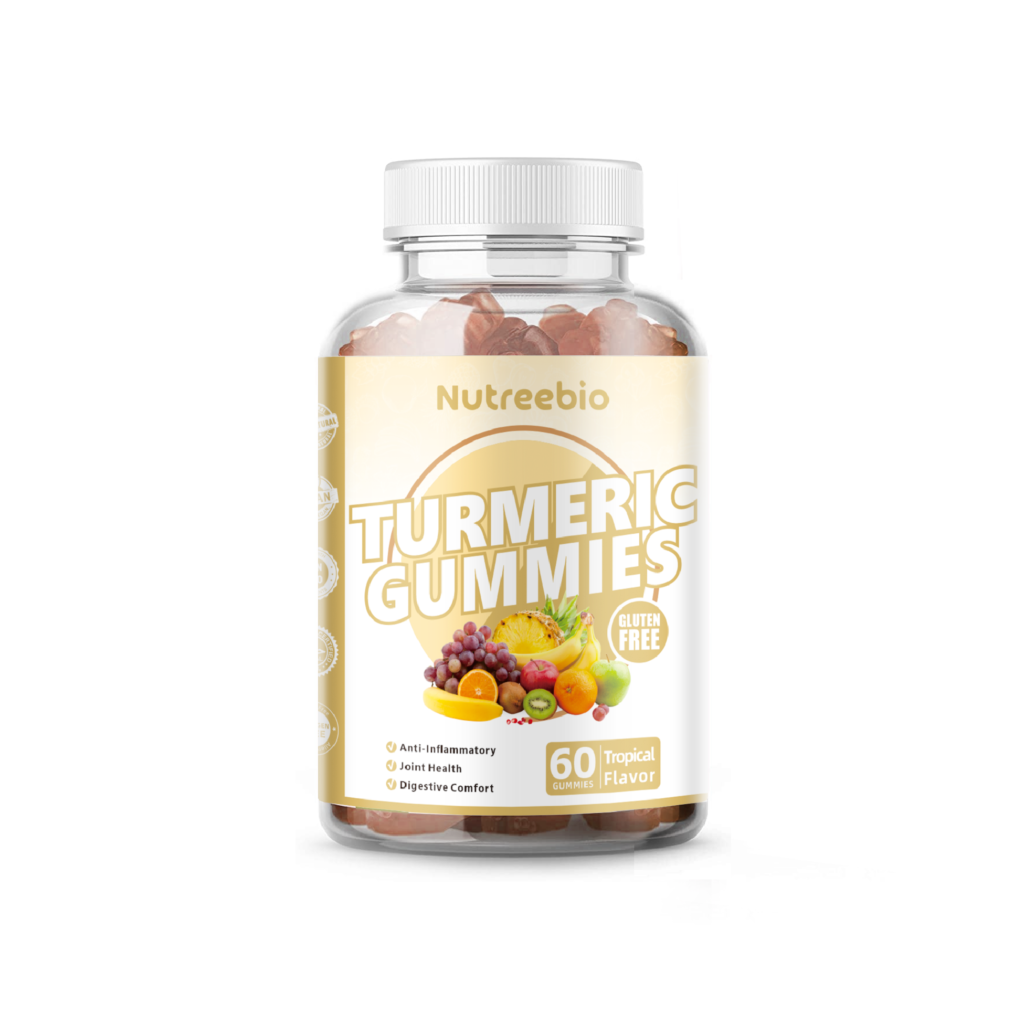Curcumin, also known as curcumin and acid yellow, is a natural phenolic substance extracted from the rhizomes of turmeric, zedoary, mustard, curry, and turmeric plants of the ginger family. Curcumin has good antioxidant, anti-inflammatory, anti-cancer and anti-diabetic potential, and can also be used as a neuroprotectant and to inhibit the viral activity of human immunodeficiency virus. In addition, as a natural pigment, curcumin is widely used in cakes, candies, beverages, sausage products, canned foods, etc. due to its strong coloring properties. Most of the existing artificial pigments will cause certain harm to the human body, while curcumin, as a natural pigment, is almost non-toxic and harmless.
According to public data, the global curcumin market size has been growing year by year, and it is expected to continue to maintain steady growth in the next few years. In 2021, the global curcumin market size is about 69.27 million US dollars, and it is expected to continue to grow at an average annual compound growth rate of about 8.9% from 2022 to 2027, of which the annual compound growth rate in the food application market will exceed 11%.
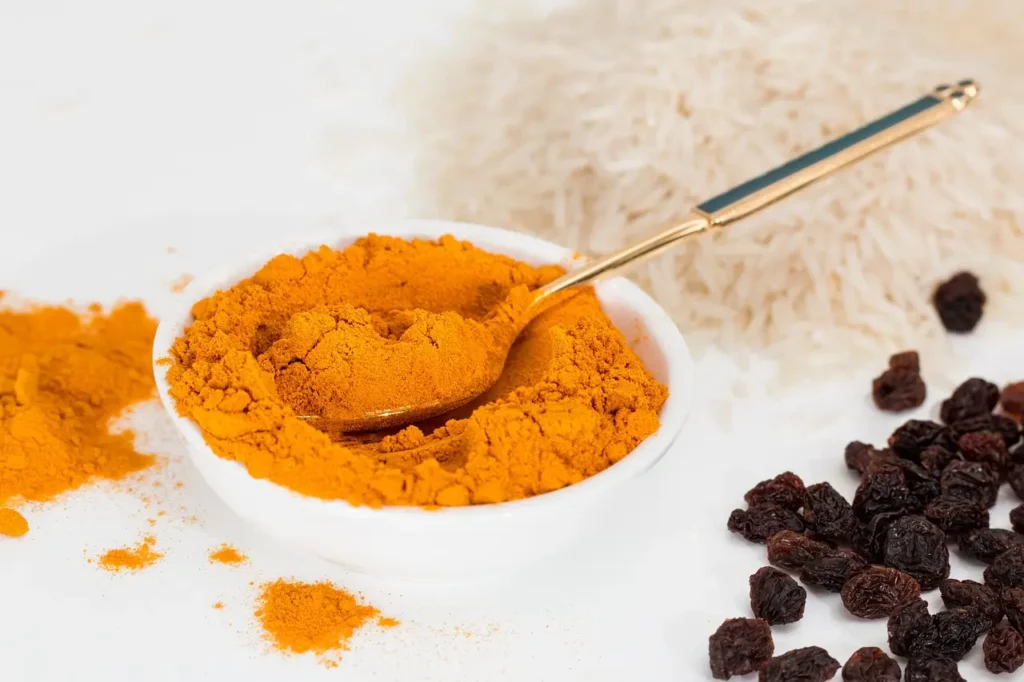
1. Health Benefits of Curcumin
A. Anti-tumor
Curcumin inhibits tumor growth mainly by reducing the number of tumors and reducing the size of tumors. Curcumin can not only inhibit the initial formation of tumors, but also inhibit tumor progression. Animal experiments have shown that curcumin can inhibit skin cancer, gastric cancer, duodenal cancer, colon cancer and breast cancer in animals, and can also prevent the metastasis of melanoma cells in mice and inhibit the growth of lymphocytes. A large number of in vitro tests have shown that curcumin also has an inhibitory effect on the growth of tumor cells such as glioma, leukemia, lung cancer, and kidney cancer.
B. Anti-inflammatory effect
Studies have shown that curcumin has a certain effect on acute, subacute and chronic inflammation. The anti-inflammatory effect of curcumin is roughly the same as that of anti-inflammatory drugs with dangerous side effects such as indomethacin and phenylbutazone. Because curcumin is a natural anti-inflammatory drug with less toxic side effects, many scholars have been keen on studying the anti-inflammatory properties of curcumin and its clinical application. Studies have found that curcumin has a significant therapeutic effect on non-alcoholic fatty hepatitis in rats.
C. Antioxidant
Curcumin is an antioxidant with multiple functional groups. From a structural analysis, curcumin is based on two phenyl acryloyl groups as the skeleton, which are respectively connected to a phenolic hydroxyl group and a methoxyl group, and the acryloyl group is connected to a β-diketone (enol) structure. Some scholars have shown that the antioxidant activity of curcumin is related to the phenolic hydroxyl group. The phenolic hydroxyl group is a necessary structure for curcumin to scavenge oxygen-free radicals. On this basis, the methoxyl group increases its antioxidant activity, and the two are in a reinforcing relationship. Related studies have pointed out that curcumin has a greater antioxidant effect than vitamins, polyphenols, and flavonoids, and is a natural antioxidant worthy of further testing and clinical research. At the same time, there are also reports that curcumin is both a free radical scavenger and a hydrogen donor, which determines that curcumin has dual activities of pro-oxidation and antioxidant properties.
D. Protect the liver
It is reported that curcumin has the effect of protecting the liver. A scholar from the Medical University of Graz, Austria, concluded through experimental research that curcumin can alleviate the deterioration of hepatitis and has a certain protective effect on the liver. Other scholars have also found through investigations and studies that curcumin has a protective effect on hepatocytes that have undergone ischemia, but there is no clear conclusion on the impact on the liver itself. Other studies have shown that curcumin can protect the liver from peroxidation damage caused by algae toxins and has a certain preventive effect on this type of liver damage. Studies have found that curcumin can reduce the level of liver tumor necrosis factor, thereby protecting the liver.
2. Regulatory dynamics
In the United States, turmeric has passed GRAS certification (GRN No.822.686,460):
- GRN No.822: Turmeric can be used as an ingredient in various food categories, excluding infant formula and foods under the jurisdiction of the US Department of Agriculture, with a content range of 0.5-100 mg/100g;
- GRN No.686: Turmeric (Curcuma longa L.) can be used as a nutritional supplement in yogurt, nutrition bars, smoothies and medical foods, providing up to 60 mg of turmeric per serving:
- GRN No.460: Purified curcuminoids in turmeric (Curcuma longa L.) can be used as a flavoring agent, flavor enhancer, or ingredient in baked goods soups, snack foods, imitation dairy products and seasonings, with a content of up to 20 mg per serving.
In the European Union, the expert panel agreed with JECFA's view that turmeric is not carcinogenic and eliminated concerns about its genotoxicity. The current database supports the ADI (acceptable daily intake) value of 3 mg bw/day derived from reproductive toxicity studies.
In South Korea, turmeric is a food additive, which is a yellow-dark reddish-brown liquid, block, powder or substance with a slight characteristic odor. It is mainly used as a colorant. Diluents, stabilizers or solvents can be added to adjust the color value and maintain quality; it cannot be used in the following foods: natural foods (meat, fish and shellfish, fruits, vegetables, algae, legumes, beans and their simply processed foods (peeled, cut into pieces, etc.)); tea; coffee: chili powder, chili strips: kimchi products: chili sauce, seasoned hot sauce: vinegar.
In Japan, curcumin is an existing food additive, mainly used for coloring.
In 1981, my country(China) first permitted curcumin as a food additive in the "Hygiene Standards for the Use of Food Additives". In 1995, curcumin was approved as a food additive by the Codex Alimentarius Commission of the Food and Agriculture Organization of the United Nations. At present, my country's standards for curcumin mainly include GB 2760-2014 "National Food Safety Standard for the Use of Food Additives" and GB 1886.76-2015 "National Food Safety Standard for Food Additive Curcumin". Among them, GB 2760-2014 stipulates that curcumin is a pigment food additive and can be consumed in a variety of foods such as cakes, beverages, beverage concentrates, alcoholic beverages, fruit and vegetable juices and fruit juice drinks, candied fruits, meat products, etc. Recommended dosage: Use in appropriate amounts according to the needs of colorants, with a maximum usage of 0.7 g/kg.
3 Market dynamics
The absorption of natural curcumin in the body is relatively poor, mainly because curcumin is a fat-soluble compound, which means that it is more easily dissolved in fat than in water. Therefore, if it is not ingested with fat, the absorption of curcumin may be limited. In addition, our stomach secretes a large amount of gastric juice, with a pH value between 0.9-1.5, which is a strongly acidic environment. Once curcumin enters the stomach, most of it will be converted into other substances, thus losing its original effect. Therefore, processed curcumin products are usually purified and then some methods are used to promote the absorption rate. Now, most of the products on the market stimulate the intestinal tract to open channels by adding piperine, thereby promoting the absorption of curcumin. For example, Nutreebio's Turmeric Gummies, each of which contains 270 mg of curcumin and Ginger extract, are mainly for joint health. Generally speaking, we recommend adding piperine to gummies, which can significantly improve the bioavailability of curcumin. There is also the Phytosome® technology developed in Italy, which combines curcumin and 100% food-grade lecithin into a stable ingredient that can be directly transported into the cell membrane, increasing its bioabsorption rate by 30 times, so that curcumin can be fully absorbed and utilized by the human body.
With the continuous development of the turmeric market, suppliers have also been accelerating their market layout in recent years. No longer satisfied with just selling it as a raw material product alone, but launching more and more diversified curcumin products to meet the needs of consumers at different levels and application scenarios.
4. Current status of production technology
Currently, curcumin is mainly extracted from plants, but this process wastes land resources, is time-consuming, and depends on seasonal changes. Therefore, our current technology is to produce curcumin by green and sustainable microbial fermentation. The synthesis of curcumin can be divided into three stages. First, glucose or glycerol synthesizes tyrosine through glycolysis, pentose phosphate pathway, and shikimic acid pathway. Second, tyrosine undergoes continuous deamination, hydroxylation, and methylation to generate ferulic acid. Third, ferulic acid undergoes acylation, polyketide, and condensation with feruloyl-CoA to generate curcumin. At present, the biosynthesis of curcumin has been studied, but its yield is still affected by excessive accumulation of intermediates, limited synthesis of cofactors, and imbalance of metabolic pathways. Therefore, how to synthesize curcumin by biological methods and obtain higher yields is an urgent problem to be solved.
5. Introduction to Nutreebio's technical achievements
In order to overcome the problems and shortcomings of existing technologies, Nutreebio is also constantly updating its technology: curcumin synthase from turmeric is expressed in Escherichia coli to achieve higher yields of curcumin synthesis. On this basis, the connection mode and expression intensity of DCS and CURS1 were optimized; the transcriptional regulator fadR of fatty acid metabolism regulation was knocked out to enhance the β-oxidation pathway and thus increase the supply of acetyl-CoA, the precursor of malonyl-CoA; the mcrC encoding malonyl-CoA reductase was knocked out to reduce the endogenous consumption of malonyl-CoA in Escherichia coli; the efflux protein srpB from Pseudomonas putida was expressed to enhance the secretion of ferulic acid and reduce the toxicity of ferulic acid to host cells. Finally, the curcumin production at the shake flask level was increased to 137.5±3.0 mg/L. The obtained Escherichia coli engineered strain was induced to ferment for 55 h, and the curcumin content in the fermentation broth was as high as 696.2±20.9 mg/L.
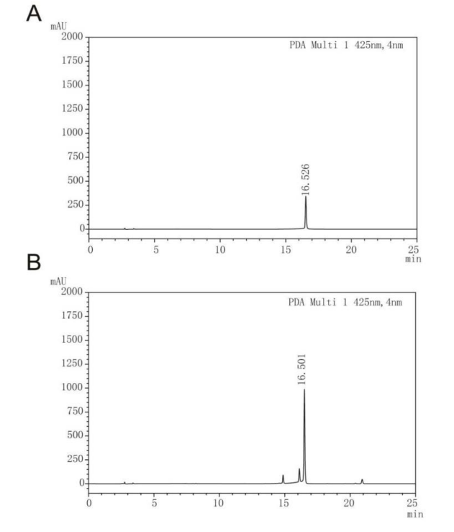
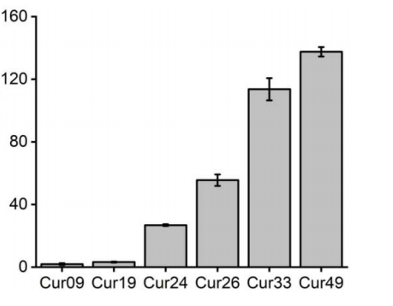
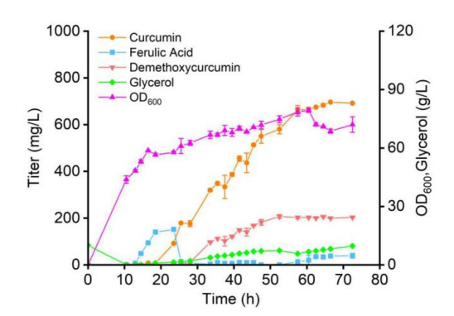
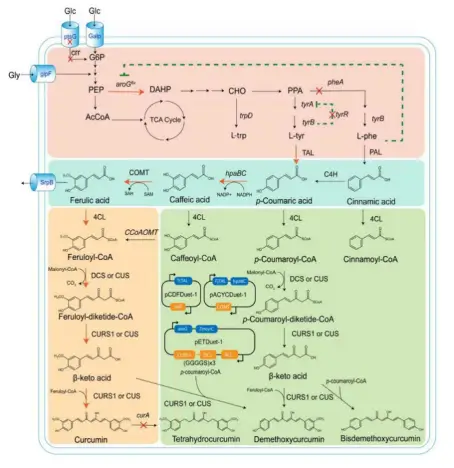
This technology heterologously expressed the turmeric-derived diketone-CoA synthase DCS and curcumin synthase CURS1 in Escherichia coli, achieving the synthesis of curcumin; and by introducing a flexible connecting peptide, the curcumin production was increased. By knocking out the competition pathway and degradation pathway of malonyl-CoA, knocking out the endogenous degradation pathway of curcumin, and overexpressing efflux proteins, the yield of curcumin was significantly increased. After optimization in the fermenter, the yield of curcumin was further improved. The curcumin yield of the constructed engineered strain can reach 696.2±20.9 mg/L, providing a more efficient method for the industrial production of curcumin and its derivatives.

